The 10 Best Pooper Scoopers to Buy in 2026
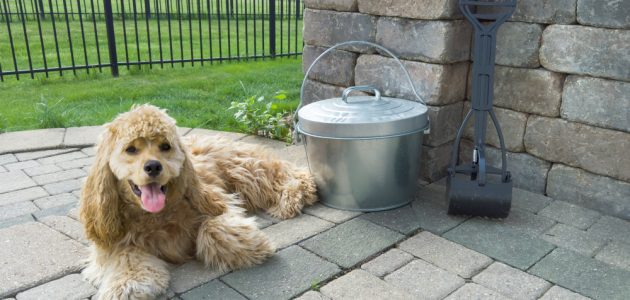
As much as we care for our pets, we don’t exactly love the gifts they leave for us in our yards. Dodging doodie landmines is certainly annoying, but the reasons to pick up after your pets go far beyond keeping the bottoms of your shoes clean.
When left on the ground, animal waste can introduce harmful pollutants that impact human and wildlife health. Many communities require pet owners to clean up after their dogs when walking through parks and other public areas. But pet owners may be interested in taking that a step further and ensuring their private property is free of dog poop and other animal waste.
Doing so in the most efficient way could mean investing in a pooper scooper, so let us scope out for you the best products to help you complete this dirty job.
- Factors to Consider When Buying Pooper Scoopers
- Top 10 Best Pooper Scoopers 2026
- 1. Best Overall Pooper Scooper: Petmate Arm & Hammer Swivel Bin & Rake
- 2. Best Budget Pooper Scooper: Dogit Waste Scoop for Grass & Gravel
- 3. Best Premium Pooper Scooper:: Expawlorer Tray and Rake
- 4. Best Travel Pooper Scooper: DogBuddy Portable Poop Scooper
- 5. Most Durable Pooper Scooper: Nature’s Miracle Non-Stick Jaw Scoop
- 6. Most Versatile Pick: Balhvit Pooper Scooper
- 7. Easiest to Store: Degbit Long Handle Pet Pooper Scooper
- 8. Nearly Indestructible Pick: PPOGOO Non-Breakable Pet Pooper Scooper
- 9. Best for Bigger Dogs: Paws & Pals Pooper Scooper for Large Dogs
- 10. Easiest to Use: Four Paws Wee Wee Dog Waste Pooper Scooper
- Guide to Buying the Best Pooper Scooper
- The, Uh, Bottom Line
Factors to Consider When Buying Pooper Scoopers
Picking out the best pooper scooper is a more complex task than it might seem at first glance. You’ll need to think about the area your pets use as their toilet, who in your household will be doing the actual pickup, how you’ll dispose of the stinky mess, and many other factors.
Pooper Scooper Style
Several styles of pooper scoopers are available, and which is right for you depends on a lot of factors unique to your needs. No one style is necessarily best, but there are two you’ll most commonly come across.
- Jaw scoop. These have scoopers that open and close like a mouth; you place it around the poop while open, then shut the “jaw” with a trigger on the attached handle.
- Rake/shovel and bin. These are very similar to a broom and dust bin. You shovel or rake the poop directly into a bin to contain it.
For a more detailed look at the pros and cons of each style, check out our full guide to pooper scooper styles below.
The Landscape It’ll Be Used On
Where your dog does his business is another important factor. Picking up piles from thick grass is a different task than taking turds off concrete or asphalt. Dog owners may want to consider a product that does both, like the Balhvit Pooper Scooper.
Pet Number, Type, and Size
Whether you’re cleaning up after a dog, cat, or another type of pet, you’ll need to be well-acquainted with what your best friend leaves behind after a meal. To pick the right pooper scooper, you need to know when they go, where they go, and how big their poos are.
Frequency of Collection
Knowing how often you’ll be scouring your yard for nuggets is another important factor. If your collections are less frequent, you may want to consider products that can hold a few days’ waste at once.
Disposal Method
How will you get your pet’s waste from the scooper into the trash or toilet? Some products are designed to allow you to scoop the poop straight into a bag that you can then detach and toss. Others will need to be hosed off regularly.
Who Will Use the Pooper Scooper?
The family member responsible for carrying the load is another primary consideration. Many products geared toward children can help parents teach their kids about responsibility, but this isn’t right for every house.. To find out if it’s right for yours, jump to our detailed guide below.
What’s Your Budget?
For any new purchase, price is always a factor. The good news for those in the market for a pooper scooper is that few of them will cost more than $15 or $20.
How We Chose the Best Pooper Scoopers
The most important factors in choosing the best pooper scooper for your family may vary, but here’s a look at how we determined the best of the best, as well as what you’ll see in each review.
Style
Most but not all products we reviewed are either rake/shovel and bin, or jaw scoop.
Durability
This covers the sturdiness of the materials used in construction and how well products hold up to repeated uses and cleanings.
Ease of use
Your dog uses your yard as a toilet multiple times per day, so products need to be easy for you to use daily or several times per week.
Versatility
Products that can only be used on one type of landscape aren’t bad products necessarily, but versatile products will have a leg up (see what we did there?).
Good to Know
This category includes other benefits or drawbacks that don’t fit into other categories, such as if products are the only ones to offer certain features.
Value
None of the products we reviewed were particularly pricey, but some certainly provide a bigger bang for the buck than others.
With these factors in mind, let’s dive into the best pooper scoopers on the market.
Top 10 Best Pooper Scoopers 2026
1. Best Overall Pooper Scooper: Petmate Arm & Hammer Swivel Bin & Rake
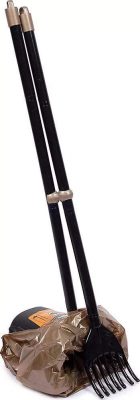
Editor’s Rating:
Why we like it: Petmate’s Arm & Hammer swivel bin design allows for maximum flexibility in collection and disposal, and while it’s more expensive than the average pooper scooper on our list, it’s an excellent value.
Style: Rake and bin
Durability
The plastic material feels sturdy, and the swivel function works smoothly even with regular use. The bin itself has hooks on the side where users can attach a small trash bag or plastic grocery bag for even easier cleanup.
Ease of Use
Because of its adjustable handle, this is an excellent product in homes where more than one person will be doing the doodie duty, and the rake and bin handles snap together for easy storage. This may not be the ideal bin for small dogs as the bin itself is made of thick plastic, and it can be a challenge to get small bits of poop inside.
Versatility
Only a rake head comes with this product, but the rake has several teeth with only small spaces between. This pooper scooper will be useful across several types of terrain.
Good to Know
Petmate’s products are the only bin-based units that swiveled, and this model is one of the few that’s built to work with or without a bag.
Value
The added features designed into this product help offset a higher-than-average price.
Pros
- Adjustable handle
- Bin designed to work with or without bags
- Durable construction
Cons
- Higher-than-average price
- Getting small poops into the thick plastic bin can be challenge
2. Best Budget Pooper Scooper: Dogit Waste Scoop for Grass & Gravel
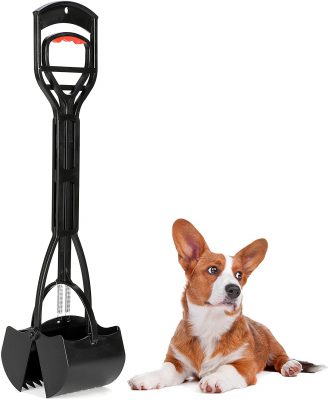
Editor’s Rating:
Why we like it: This is one of the most consistently functional jaw scoop-style pooper scoopers we looked at, and Dogit offers units designed for different types of terrain.
Style: Jaw scoop
Durability
Durability is a crucial concern with jaw scoop-style pooper scoopers, since the mechanism has moving parts that can wear out. But Dogit’s grass and gravel unit holds up to regular and the spring action works consistently day after day.
Ease of Use
The spring-loaded bucket snaps closed in one motion, and the bucket itself is quite sizable for a jaw-style scooper. Depending on their height, users may need to bend slightly at the waist to reach the … waste.
Versatility
Dogit also offers a unit designed for pavement, which has a flat-edged scoop rather than the sawtooth-style edge in the grass and gravel unit. Users who need both would have to invest in two products.
Good to Know
The unit is 25 inches tall, so it should be the right size for most adults, but the very tall may find it annoying to constantly bend to reach. For a pooper scooper that may work for taller users, check out the Expawlorer Tray and Rake instead.
Value
Dogit’s grass and gravel jaw scoop comes at a below-average price, but it’s even better than many of the more expensive jaw scoop products.
Pros
- Brand offers multiple scoop options
- Spring-loaded action works even after repeat use
- Light weight makes long sessions tolerable
Cons
- Not ideal for tall people
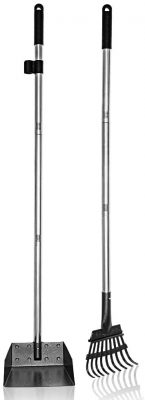
Editor’s Rating:
Why we like it: The adjustable length makes it ideal for multiple-human households, and the construction and material choices make this feel very solid and durable.
Style: Rake and scoop
Durability
The handles themselves are lightweight, but the rake and bin heads feel quite solid and sturdy. Both are finished with a coating that makes them easy to clean.
Ease of Use
The adjustable handles must be assembled, but once they are put together, use is simple.
Versatility
With a rake head, this is not the ideal product for those cleaning waste off asphalt or concrete, but the rake itself is suitable for varying lengths of grass as well as gravel or mulch. If you need a scooper for concrete, consider the PPOGOO Non-Breakable Pet Pooper Scooper instead.
Good to Know
Gaps in the rake are wide, so those with smaller dogs may have a tough time corralling the poop.
Value
This was the most expensive product we reviewed, but it is something of a no-frills option, which will turn some people off given its price.
Pros
- Solid feel
- Clip included for easy storage
- Adjustable handle length
Cons
- Above-average price
- No bells and whistles
4. Best Travel Pooper Scooper: DogBuddy Portable Poop Scooper
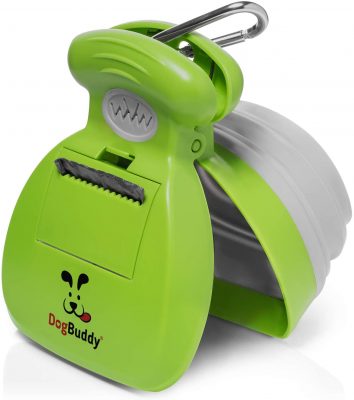
Editor’s Rating:
Why we like it: This compact — dare we say cute — pooper scooper is ideal for walks, hikes, or even car trips.
Style: Jaw scoop
Durability
Very little can go wrong with this, well, very little product. The simple jaw scoop action is operated by pressing on the ends, and the hard outer material means this can stand up to regular use and vigorous cleaning.
Ease of Use
Unlike the Expawlorer Tray and Rake, there’s no long handle with this product, so for those who are squeamish, this isn’t the answer. But it does provide protection for those who do daily poop pickup in their own yards or want to have something more than bags for walks.
Versatility
The flat edges and compact size mean it’s easy to get this little unit into just about any space where you need it to go. DogBuddy also offers a large size meant for medium- to large-sized dogs.
Good to Know
Not ideal for infrequent yard cleanup, but perfect as a daily-use product.
Value
The price is above average, but its unique design is perfect for a specific niche of users.
Pros
- Compact and extremely portable
- Simple operation
- Designed to be used with bags
Cons
- Requires bending down
- Essentially like using a poop bag
5. Most Durable Pooper Scooper: Nature’s Miracle Non-Stick Jaw Scoop

Editor’s Rating:
Why we like it: Durable construction makes this almost satisfying to use as the strong clamp of the jaw picks up a fresh pile.
Style: Jaw scoop
Durability
This product is made of hard, heavy plastic, which makes it stand up to repeated use.
Ease of Use
The function is simple, and use is intuitive. However, those who opt for the jumbo version may find their hands cramp when they pull the scoop trigger, and this could be a problem if the product needs to be used for more than a few minutes at a time.
Versatility
With sawtooth edges, this scoop is less than ideal for use on concrete or asphalt, unlike the PPOGOO Non-Breakable Pet Pooper Scooper which handles asphalt with ease. It’s offered in multiple sizes, so you’re likely to find a version that works for you; you could even keep several sizes around for different jobs.
Good to Know
It’s coated with non-stick material that’s been treated with antimicrobials.
Value
This is one of the most expensive products we reviewed, but it also feels the sturdiest.
Pros
- Sturdy, durable construction
- Multiple size options
- Non-stick, antimicrobial material
Cons
- No way to attach bag
- Larger size requires better grip strength
6. Most Versatile Pick: Balhvit Pooper Scooper
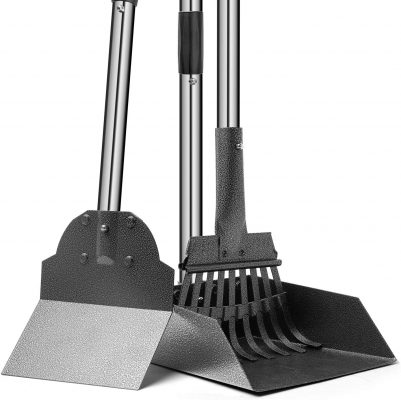
Editor’s Rating:
Why we like it: Balhvit’s pooper scooper comes with two types of handles — a rake and a scoop, making it ideal for homes where many types of cleanup are needed.
Style: Rake/shovel and bin
Durability
The sturdy construction of the Balhvit unit is clear when you put it to the test against your dog’s lawn leavings.
Ease of Use
A pair of clips on the bucket handle help keep the shovel and rake handy and under control, though users likely will want to remove one of the two when they’re doing pickup.
Versatility
This is the only product we reviewed to come with both a shovel and rake to let users take advantage of both options.
Good to Know
The tray and spade extend up to 37 inches, and the rake extends up to 29 inches.
Value
This is one of the most expensive products on the list, but given that you essentially get two pooper scoopers in one, it’s well worth it.
Pros
- Shovel and rake included
- Non-stick coating allows for easy cleaning
- Essentially two scoopers for the price of one
Cons
- Above-average price
- No ability to attach bags
7. Easiest to Store: Degbit Long Handle Pet Pooper Scooper
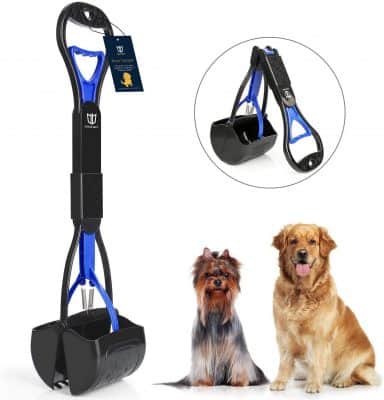
Editor’s Rating:
Why we like it: The collapsible design makes this jaw scoop-style product stand out among competitors.
Style: Jaw scoop
Durability
With strong, heavy plastic and a collapsible design, Degbit’s long-handled jaw scoop-style scooper stands up to regular use.
Ease of Use
Collapsing the device for easy storage or travel is simple, and the jaw scoop action is intuitive.
Versatility
The scoop’s edges have a unique design that, unlike many other products, don’t have the sharp sawtooth style that can make collecting from flat surfaces a challenge. If the sawtooth style would work better for your landscape, try the Nature’s Miracle Non-Stick Jaw Scoop instead.
Good to Know
At a 24-inch length, particularly tall people might have a challenge, but most adults will find it ergonomic. Taller users may want to give the Expawlorer Tray and Rake a try.
Value
The price is slightly below average, and the collapsible feature is unique enough to make it a good option for those who need that feature.
Pros
- Collapsible for easy transport and storage
- Non-stick coating is easily cleaned
- Strong jaw clasp strength
Cons
- Only comes in one size
- No way to attach bags
8. Nearly Indestructible Pick: PPOGOO Non-Breakable Pet Pooper Scooper
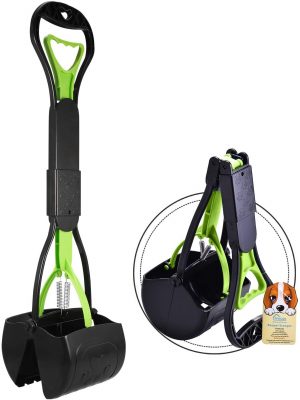
Editor’s Rating:
Why we like it: Nearly identical to another unit on this list, the Nature’s Miracle Non-Stick Jaw Scoop, PPOGOO’s jaw scoop-style pooper scooper is allegedly unbreakable.
Style: Jaw scoop
Durability
Heavy plastic and solid construction make this product useful even though it’s also collapsible.
Ease of Use
Folding the item up for travel or storage is quite simple, and the function of the jaw scoop is the same as most others on this list.
Versatility
The scoop’s edges aren’t as sharp as other products on the list, which makes this scooper useful on flat surfaces like concrete or asphalt.
Good to Know
The scoop bucket does not close completely, so it’s possible for small bits to fall out.
Value
At the low end of the price range, the collapsible design of this unit makes it unique.
Pros
- Collapsible handle
- Can be used on multiple terrains
- 24-inch handle ideal for most adults
Cons
- Bucket doesn’t close completely
9. Best for Bigger Dogs: Paws & Pals Pooper Scooper for Large Dogs
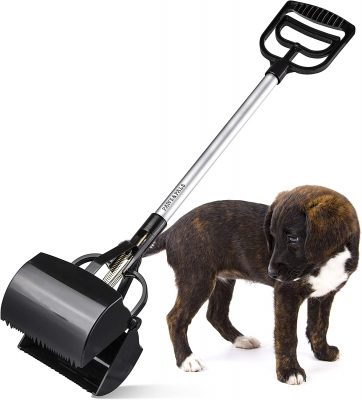
Editor’s Rating:
Why we like it: This is the best product — in fact, one of the only products — we reviewed that’s geared toward owners of large dogs.
Style: Jaw scoop
Durability
The plastic handles and scoop bucket and metal handle make this product feel very sturdy and reliable, and the large size is equal to the task of large dogs’ poops.
Ease of Use
With an extendable handle, even tall people should find this product easy to use with its strong spring-loaded action.
Versatility
Serrated teeth on the jaw will make it challenging to use on flat surfaces like asphalt and concrete.
Good to Know
It’s made for bigger dogs, but owners of small dogs may find it useful if they are infrequent cleaners, as with the proper maneuvering, they could hold a couple of days’ worth of droppings in the bucket at once.
Value
With a relatively low price, this is ideal for budget-conscious owners of large dogs, but it’s a no-frills option.
Pros
- Strong spring-loaded jaw response
- Adjustable handle
- Low price
Cons
- Only offered in one size
- No special features
10. Easiest to Use: Four Paws Wee Wee Dog Waste Pooper Scooper
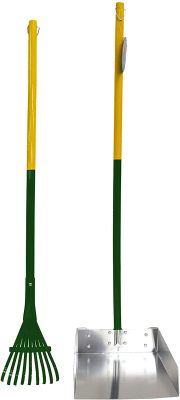
Editor’s Rating:
Why we like it: Four Paws’ rake-and-bin pooper scooper has a unique style and offers a large scoop ideal for collecting several days’ worth of waste.
Style: Rake and bin
Durability
The green-and-yellow scooper is unique, and the vinyl-coated wooden handles connected to the strong metal rake and bin feel quite substantial to use.
Ease of Use
While the function is simple and straightforward, the product lacks a way to connect the bin handle to the rake handle, so storage is less convenient than in some other products.
Versatility
The bin’s edge is thin, so getting differently sized bits into it is simple, and the rake’s teeth are spaced close together. It’s a rake style, and that can be a challenge on flat surfaces, but the short-edged bin compensates.
Good to Know
If you’ve designed your house in a John Deere tractor style, this rake-and-bin set is ideal for you.
Value
This is by far the cheapest product on our list, and given that it offers no additional features, that’s not surprising.
Pros
- Easy to use
- Unique color combination
Cons
- No special features
Guide to Buying the Best Pooper Scooper
Everybody poops, including your pets. Cleaning up after them is important for several reasons and figuring out how to go about doing this crappy job in the best way isn’t always simple. Here’s a look at everything you need to know to pick the best pooper scooper for you.
Can I Just Leave Dog Waste in My Yard?
Ruining your favorite pair of flip-flops is certainly a risk you run when your dog’s waste is left in your yard. But the U.S. Environmental Protection Agency (EPA) lists pet waste as an environmental hazard, and if it’s left exposed to rain, the toxins can make their way into local waterways, causing a number of diseases in humans. Because of this, you should be certain to never leave your dog’s waste just lying on the ground—however tempting it may be.
Is Dog Poop Harmful?
In a word, yes. Dog waste contains several types of bacteria and parasites, and the EPA classifies pet droppings as “nonpoint source pollution,” meaning pollution that results from rain, snow melt, or drainage. The agency lists dog poop and other pet waste in the same category as toxic chemicals from energy production.
According to the federal Centers for Disease Control and Prevention (CDC), contact with poop from domestic pets like dogs and cats can cause humans to become infected with many types of bacteria, diseases, and parasites, including:
- Campylobacter: Causes diarrhea, fever, and abdominal cramps; most harmful for children under 5, adults 65 and older, and those with weakened immune systems.
- Cryptosporidiosis: Causes watery diarrhea with cramping, abdominal pain, nausea, and vomiting.
- Echinococcosis: Though rare, parasite can cause a tapeworm infection in humans that can lead to the development of cysts in bodily organs.
- Giardia: Can cause diarrhea, gas, and dehydration.
- Hookworm: Small worms spread through skin contact with animal waste. Though rare, hookworm infection can cause intestinal inflammation in humans.
- Roundworm: Two types of roundworm can infect people. One type affects the eyes and can lead to vision loss or retinal damage, and the other affects organs like the liver, lungs, and central nervous system, causing fever, fatigue, abdominal pain, and wheezing.
- Salmonellosis: Infection symptoms include diarrhea, fever, and abdominal cramps. At-risk people, such as the very young or very old, may require hospitalization in the case of severe salmonella
- Toxoplasmosis: Most often found in cat poop, toxoplasma gondii can cause flu-like symptoms in humans.
Humans aren’t the only ones threatened by dog poop. Dogs themselves also could get sick. That’s because some dogs have a nasty habit of eating their poop or the poop of other dogs. The scientific term for this particularly gross activity is coprophagia, and while it can have many causes, one study found that about one in four dogs had eaten poop at least once, and 16% were habitual turd-tasters.
Poop eating can be a sign of a behavioral or health problem in dogs, so if your dog is eating its own stool or the poop of other pets, be sure to discuss this with your dog’s vet. It may be necessary to have lab tests on your dog’s blood and stool to rule out parasitic infection, and you’ll need to be sure to eliminate any future triggers of habitual poop eating.
The American Kennel Club has identified several reasons why dogs might eat poop, such as:
- Anxiety
- Isolation
- Attention-seeking
- Eating their food in proximity feces
- Restrictive confinement
Are There Alternatives to Pooper Scoopers?
Some dog owners may be able to avoid the need to scoop poop in the first place, though this can depend on the size of the dog and the owners’ level of skill (and patience) with training. The two best alternatives to pooper scoopers are indoor litter boxes, like those used by cats, or training your dog to use a toilet.
Toilet Training
Anybody who has ever had a puppy already knows the term “toilet training,” but they probably assume it means training the dog not to use the potty in the house. But some dog owners may be able to train their dogs to use the toilet in a bathroom inside their house.
This requires an extreme level of dedication, as it’s not necessarily a natural transition for a dog, especially an adult dog. Check out the steps needed and decide for yourself if it’s possible (or advisable).
Litter Boxes
Most dogs can be trained to use litter boxes just as cats are, and there are several products designed for apartment dwellers and others who don’t have outdoor spaces where their dogs can relieve themselves. These boxes come in a couple of varieties — those with absorbent materials like newspaper or clay and those designed to mimic the look and feel of grass.
The first type functions just like a cat’s litter box, with liquid and solid waste coming into contact with the litter material and drying out, which makes disposal easier. The second type is an elevated platform with a patch of artificial grass over a slotted tray that drains into a receptacle. This receptacle can be drained and cleaned, and some products allow for puppy pads or newspaper to be placed into the receptacle. It’s also easier to remove droppings from the artificial turf than from real grass since the turf material is shorter than grass.
What Pooper Scooper Style Is the Best?
Which style of pooper scooper is best depends on a ton of factors and is largely a matter of personal preference. The good news is that most pooper scoopers are cheap, so it may be possible to experiment with a few types before settling on the one that’s right for you. Let’s check out the characteristics of the two main types: jaw scoops, and rake/shovel and bin.
Jaw Scoop
Jaw scoop pooper scoopers work by placing the open scoop around the poop and then pulling or hitting the trigger of the handle. This causes the jaw to close around the poop, letting the user lift it off the ground and dump it into a bag or bucket for disposal.
Some jaw scoops are designed so that the scoop itself can be covered with a bag, and many are collapsible for easy storage. These all-in-one units may be more suitable for homes with small dogs, given the limits of the size of the scoop.
With jaw scoops, another consideration is the edge design of the scoop. Those with particularly sharp edges may get caught on a hard surface like concrete or asphalt and make pickup a challenge. Some jaw scoop versions are designed specifically for pavement.
Rake/Shovel and Bin
This is the more traditional style of pooper scooper, and this format is based on the simple premise of a broom and dust bin. Some units come with rakes, while others come with flat-headed shovels or trowels.
Some bin units are made to swivel, and some bins can take bags for easier disposal. Some but not all units will require assembly, and most come with clips to keep the rake/shovel handle and bin handle attached.
Users will be more likely to find adjustable handles if they go with this type of scoop.
Other Factors
The form factor of the pooper scooper isn’t the only consideration that goes into deciding the best product for you. While the ergonomics of how each style functions is important to note, here’s a look at the other important factors you’ll need to consider before deciding:
- Landscape: Jaw scoops with jagged edges aren’t best for those collecting turds from asphalt or other relatively flat surfaces. The edges may prevent the scoop from closing around the droppings. But rake-and-bin styles might not work for these landscapes, either, as the teeth of the rake scraping against concrete or asphalt will be unpleasant and possibly less effective. A shovel-and-bin style may be best for those most often cleaning poop off flat surfaces.
- Pet number, type, and size: As mentioned, jaw scoops tend to have smaller collection baskets than bin-style scoopers, so these may not work for families that have several dogs or large dogs. But for homes where smaller dogs or outdoor cats live, these smaller units could be perfect. Understanding the health and consistency of your pets’ poop is also important here, as some dogs have bigger poops, while others may be prone to digestive problems.
- Disposal method and frequency of collection: How often you’ll be scooping the poop is a huge factor. If you’re doing daily pickup and delivery of dog poop, you may not need a particularly high-capacity scooper. On the other hand, if you want to be able to pick up several days’ worth of poop and have it immediately contained within a bag, you’ll need to consider a product that has a large bin that comes with bags.
Do Local Laws Apply to Dog Waste in My Yard?
Possibly, though this depends on where you live. In many cities and towns, pet owners are required to curb their cats and dogs in public areas and private spaces other than the pet owners’ property. But in other cities, these requirements extend to the owners’ property as well.
For example, the Seattle-area city of Bothell requires residents to pick up their dog’s poop from public areas as well as their own yards or face a fine of up to $250. Charleston has a similar law on the books that applies to public and private property alike, and Chicago lawmakers a few years ago considered such an ordinance, though it did not pass.
If you’re unsure about what laws apply where you live, many cities and counties have published all local codes and ordinances, or you can contact local public works or parks departments to find out what’s allowed.
Should I Get My Kids Involved?
It’s become something of a cliché, but many parents who give into their kids’ pleas for a puppy will condition the introduction of a dog into the family on their kids “taking care of” the new pet.
For parents who want to instill responsibility in their children through dog ownership, getting the kids into the habit of cleaning up their dog’s poop may be a good option. This probably isn’t the best idea for young children, as they may be susceptible to several types of parasites that can be transmitted through contact with dog poop. Very young kids may not have the physical coordination to avoid physical contact or the hygiene habits to effectively clean their hands off afterward.
If you do want your tweens or teens to take care of your dogs’ business, consider pooper scooper products that are on the shorter side, or consider investing in one long-handled and one short-handled device.
What Are the Best Practices for Using Pooper Scoopers?
A good pooper scooper is only as effective as your habit surrounding the use of the product. What are some ways to make this a task that doesn’t stink?
If you can, do the deed daily or at least weekly: The average dog poops at least once a day and probably more depending on how many times he’s fed. If you clean up the yard daily, the job will be easier than if you leave piles to accumulate for weeks.
Gather all the tools you need: Decide on how you will go about collecting and disposing of the poop and be sure to take all the tools you’ll need with you. For example, if you’re dumping your dog’s dumps into a bucket and then tossing the collected turds into the trash, bring that bucket with you rather than taking the pooper scooper to the bucket. The fewer steps it takes you, the better.
Scoop everything suspicious: Not sure if the pile before you is a gift from your dog or simply a clump of mud? Scoop it anyway. Better to accidentally scoop up some dirt than leave a turd in the yard.
Learn your dog’s patterns: Your dog probably likes to poop in the same few spots day after day, so if you pick up a pile from one area, before heading to another area, look all around that spot. Chances are good there’s another pile nearby. Alternately, train your dog to poop only in a specific area of the yard so you have a smaller area to clean.
Pick a side: According to poop-scooping experts DoodyCalls, the side of the pile that appears most stuck to the ground will be the one that’s easiest to pick up.
Clean your tools: All pooper scoopers must be regularly cleaned to ensure they are free of fecal residue. A garden hose is helpful in this effort, and getting into the habit of cleaning the scooper after every use will ensure you can get right down to business once it’s time to clean.
Don’t look away: Dog poop is gross, there’s no reason to claim otherwise. But some health problems our dogs experience can show up in their droppings. If you note a change in the color or consistency of your dog’s poop, that can be a sign of intestinal distress. Check out this article to learn more about what healthy dog poop should look like, and if you spot any concerning issues, be sure to call your vet.
The, Uh, Bottom Line
It’s a common misperception that dog waste is a fertilizer in the same way that cow feces is used to grow crops. The presence of a host of undesirable materials in dog poop means that far from helping your tomatoes grow, your dog’s waste may, in fact, make you and your family sick. Using a product designed to make this dirty job less crappy could mean improving the health of yourself, your pet, your family, and even your local waterways.




